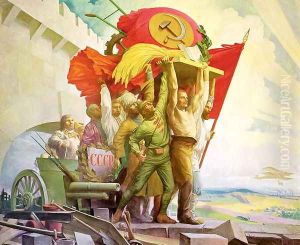Stepan Mikhailovich Karpov Paintings
Stepan Mikhailovich Karpov was a Soviet artist known for his contributions to the realm of painting, particularly in the genres of portraiture, landscape, and still life. Born in 1899, Karpov's artistic journey began in the tumultuous years of the Russian Empire and spanned through significant historical events, including the Russian Revolution and the Second World War, reflecting the profound changes in society and art during the 20th century.
Karpov received his formal art education at the VkHUTEMAS (Higher Art and Technical Studios) in Moscow, an institution that played a crucial role in the development of Russian avant-garde art. His education under the tutelage of prominent artists of the time deeply influenced his stylistic development, embedding in his work a blend of traditional and experimental techniques. Throughout the 1920s and 1930s, Karpov established himself within the Soviet art scene, adapting his style to align with the Socialist Realism doctrine, which became the official art form of the Soviet Union.
During his career, Karpov produced a significant body of work that included landscapes capturing the vastness and diversity of the Soviet Union, portraits that depicted the dignity and heroism of the working class, and still lifes that conveyed deeper symbolic meanings within everyday objects. His ability to infuse his works with emotional depth and a nuanced understanding of light and color garnered him recognition and respect among his peers. Despite the constraints of Socialist Realism, Karpov managed to maintain a personal voice, subtly incorporating elements of Impressionism and Realism that made his work stand out.
The Second World War marked a critical period in Karpov's life and career, as he was commissioned to create works that bolstered the Soviet war effort, capturing the bravery and sacrifice of the Soviet people. Post-war, his art continued to evolve, reflecting the changes in Soviet society and the gradual relaxation of strictures on artistic expression.
Karpov's contributions to Soviet art were recognized with several awards and honors throughout his career. However, like many artists of his time, his work was subjected to the shifting tides of political favor and the complex dynamics of the Soviet art world. Stepan Mikhailovich Karpov passed away in 1953, leaving behind a legacy that encapsulated the spirit and challenges of a pivotal era in Russian history. His paintings remain a testament to the skill and resilience of an artist who navigated the complexities of his time with integrity and creativity.
